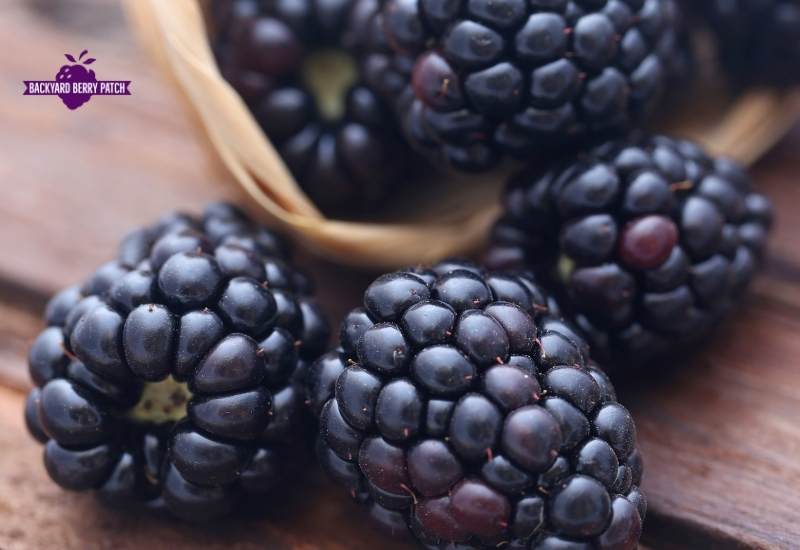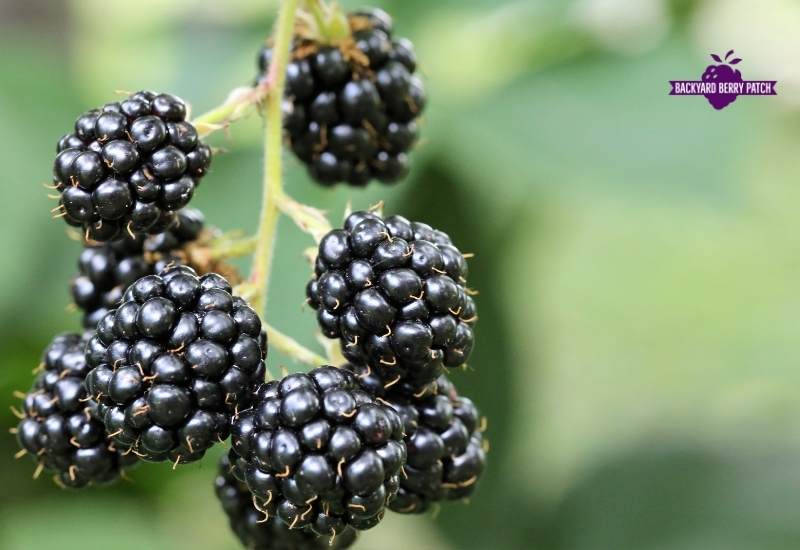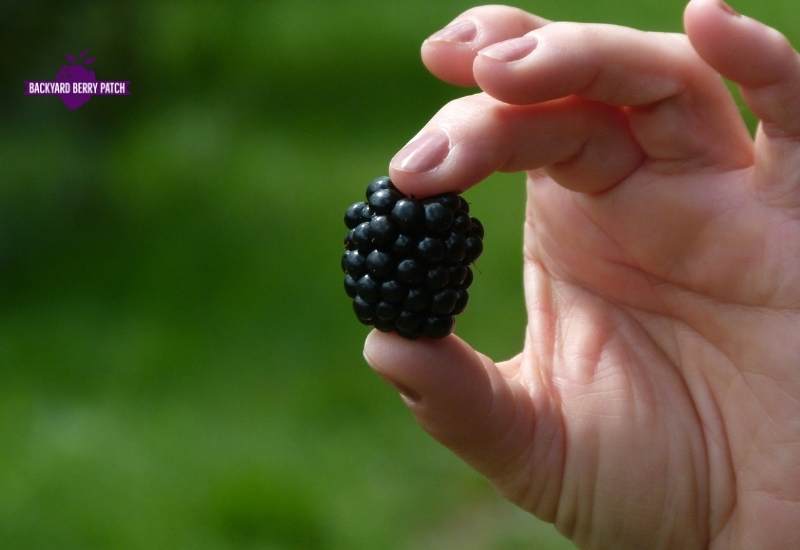Blackberries are a delicious and versatile fruit that many new gardeners might find intimidating to grow. However, with the right care and attention, cultivating a thriving blackberry patch is simple and rewarding. This guide aims to provide valuable insights and tips to help even the most novice gardener enjoy a successful blackberry harvest.
Selecting the ideal location is essential for growing blackberries. These plants require full sun and well-drained soil with a pH between 6.0-7.0. Amending the soil with compost or other organic materials can further improve the conditions for your plants. Once you’ve chosen the perfect spot, planting your blackberries at the appropriate time and distance apart will ensure a bountiful crop.
Aside from those critical initial steps, ongoing blackberry care includes proper irrigation, fertilization, and pruning practices. Being diligent with these tasks can make all the difference in your blackberry bush’s health and productivity. With this essential guide, even a beginner gardener can confidently embark on the journey of growing delicious blackberries in their own backyard.
Choosing the Right Blackberry Variety
Growing blackberries can be a rewarding experience for new gardeners. To ensure success, it’s essential to choose the right blackberry variety for your region and garden conditions. There are three main types: erect, semi-erect, and trailing blackberries.

Erect Blackberries
Erect blackberries are known for their upright growth habit, with stiff, self-supporting canes. These blackberry varieties can grow without a trellis, making them suitable for smaller gardens and easy maintenance. Some popular erect blackberry varieties include:
- Apache
- Navaho
- Ouachita
When choosing an erect variety, consider factors such as local climate and soil conditions. Erect blackberries generally prefer well-draining soil with a pH of 5.5 to 7.0.
Semi-Erect Blackberries
Semi-erect blackberries feature a mix of both erect and trailing growth habits. These varieties produce large fruit, making them popular among gardeners who value berry size. However, semi-erect blackberries require some support from a trellis or other structure. Some excellent semi-erect blackberry varieties include:
- Chester
- Triple Crown
- Doyle’s Thornless
Similar to erect blackberries, semi-erect varieties thrive in well-draining soil with a pH of 5.5 to 7.0.
Trailing Blackberries
Trailing blackberries have a unique, vining growth habit. These blackberry varieties require a trellis or other support system to keep their sprawling canes off the ground. Although more care is needed to maintain their growth, the fruit from trailing blackberries is often praised for its exceptional flavor. Some popular trailing blackberry varieties include:
- Boysenberry
- Marionberry
- Loganberry
As with the other types, trailing blackberries thrive in well-draining soil with a pH of 5.5 to 7.0 and prefer full sun.
When selecting a blackberry variety for your garden, consider factors such as space, local climate, and desired fruit characteristics. By choosing the right variety, new gardeners can set themselves up for a successful and enjoyable blackberry growing experience.
Preparing the Soil
Soil Type and pH
Blackberries thrive in loamy, well-draining soil with a pH of 5.5 to 7.0. Before planting, it’s crucial to test the soil’s pH and, if necessary, amend it accordingly. Adding lime can raise the pH, while sulfur can lower it. Maintaining the proper pH ensures your blackberries have access to essential nutrients and grow optimally. Soil Preparation for Blackberry Plants
Soil Drainage
Good drainage is essential for blackberry plants because they’re highly susceptible to root rot if their roots sit in waterlogged soil. To improve drainage, consider planting in raised beds or incorporating organic matter, such as compost or aged manure, into the existing soil. Mixing organic materials into the soil also enhances its structure and fertility. How to Grow Blackberries
Adding Nutrients
Rich, nutrient-dense soil is critical for growing healthy blackberry plants. To achieve this, amend the soil with the following:
- Compost: A generous layer of compost added to the soil will provide essential nutrients to the plants.
- Aged manure: Manure is another excellent source of nutrients, but be sure to use well-aged or composted manure to avoid burning the roots.
- Fertilizer: Apply an all-purpose fertilizer or one specifically designed for berry plants, following the manufacturer’s instructions.
Remember to mulch around the plants to help retain moisture, suppress weeds, and gradually release nutrients into the soil as the mulch breaks down.

Planting Blackberries
Selecting Plants and Planting Time
When starting to grow blackberries, it’s essential to choose the right plants and planting time. Bare root plants or young plants from a nursery are the easiest ways to get started with blackberries. Bare-root plants should be planted in spring, after the danger of severe frost has passed. Soak the roots for an hour before planting to ensure proper hydration. Ensure that the chosen plants are suitable for your local climate and soil conditions.
Spacing and Planting Depth
Proper spacing is crucial for healthy blackberry growth. Plants should be spaced 5 to 6 feet apart, and if planting in rows, space the rows 5 to 8 feet apart, allowing room for growth and air circulation (source). Blackberries should be planted relatively shallow, about 1 inch deeper than they were growing in the nursery pot. This helps to promote root growth and establishment in the new location.
Watering and Mulching
When it comes to watering and mulching, blackberries require consistent moisture, especially during the initial establishment period. Water the plants deeply and regularly, allowing the soil to dry out slightly between waterings. Mulch around the base of the plants with well-aged compost to help retain moisture, suppress weeds, and provide additional nutrients to the soil.
Supporting Blackberry Plants
Trellising
Proper support for growing blackberry plants is essential for a successful harvest. One common method of support is trellising. Trellising involves attaching the blackberry canes to a sturdy structure, such as a fence or posts with wire, to reduce the risk of damage from strong winds or heavy fruit loads.
To create a trellis for your blackberry plants:
- Install sturdy posts, spaced 5 to 6 feet apart, and insert them firmly into the ground. If planting in rows, space the rows 5 to 8 feet apart The Spruce).
- Run strong wire or twine horizontally between the posts at different heights, starting about 2 feet above the ground and continuing up to the top of the posts.
- Attach the blackberry canes to the horizontal wires, being careful not to damage the canes or restrict their growth.
- Check and adjust the attachment points regularly to accommodate the growth and weight of the plants.
Pruning
Regular pruning of blackberry plants is necessary to promote healthy growth, maintain the structure of the plants, and ensure good fruit production. Pruning should be done during the dormant season (late winter or early spring).
To prune blackberry plants:
- Remove any dead, damaged, or weak canes, cutting them back to the ground level.
- Cut back all remaining canes to a height of 4 to 5 feet to encourage lateral growth.
- Identify the fruiting canes (canes that have produced fruit) and cut them back after fruiting, as they will not produce fruit again. This ensures that only the vigorous young canes remain for future fruiting.
- Thin out the remaining canes, leaving about 4 to 6 strong canes per plant, and attach them to the trellis for support.
By providing suitable support and proper pruning, blackberry plants will be more likely to produce a healthy, bountiful harvest. Regular maintenance also helps prevent pests and diseases, as well as promoting overall plant health.
Annual Maintenance and Care
Fertilizing
Blackberries need a balanced fertilizer to thrive. Apply a balanced fertilizer, like a 10-10-10 formula, in late spring when the plants have started to grow new shoots. Spread the fertilizer around the base of each plant, keeping it a few inches away from the canes to prevent root burn. Follow the package instructions for the recommended amount, and water the plants well after applying the fertilizer.
Weeding
Keeping the area around your blackberry plants weed-free is essential to ensure they receive adequate nutrients and sunlight. Regularly remove weeds by hand or use a hoe to dislodge them, being careful not to damage the blackberry roots. Mulching the area with materials like pine straw or shredded pine bark can help conserve moisture and discourage weeds.
- Apply mulch 2-4 inches thick.
- Maintain a weed-free zone in a 2-3 feet radius around each plant.

Pest and Disease Control
Keeping your blackberry plants healthy and free of pests and diseases will ensure a bountiful harvest. Common pests that affect blackberries include aphids, spider mites, and raspberry crown borers. Monitor your plants regularly, and if you notice any pests or signs of infestation, use a targeted pesticide or insecticidal soap to control the problem.
Blackberries can also be prone to diseases like cane blight, leaf spot, and anthracnose. To prevent these diseases:
- Select disease-resistant varieties when planting.
- Prune old, fruiting canes after harvest to encourage new growth and minimize disease spread.
- Provide good air circulation by space your plants properly.
- Keep your garden clean, remove debris, and avoid overhead watering.
By following these guidelines, you will ensure that your blackberry plants get the appropriate care and maintenance they need to produce a healthy and delicious harvest each year.
Harvesting Blackberries
When to Harvest
Blackberries are typically ready for harvest between June and August, depending on the climate and variety of the plant. It’s important to pick the berries when they are fully black and mature, as they will not ripen further once picked. Mature berries should be plump yet firm, with a deep black color. During the ripening period, it’s essential to harvest the blackberries frequently, ideally every couple of days, to ensure optimal quality and taste (source).
Proper Harvesting Technique
To harvest blackberries properly, follow these steps:
- Gently pull the ripe blackberries from the canes, being careful not to yank them (source).
- Use a shallow dish or container to collect the berries, as this will help prevent them from being crushed.
- Be cautious of the juice, as it can stain your clothing. Wear gloves if desired to avoid staining your hands.
Remember that blackberries bruise easily, so handle them with care. As they don’t keep fresh for very long, it’s best to eat or process them soon after harvesting (source). Whether enjoyed fresh or made into pies, jams, and smoothies, properly harvested blackberries are a flavorful and rewarding addition to any garden.

Leave a Reply